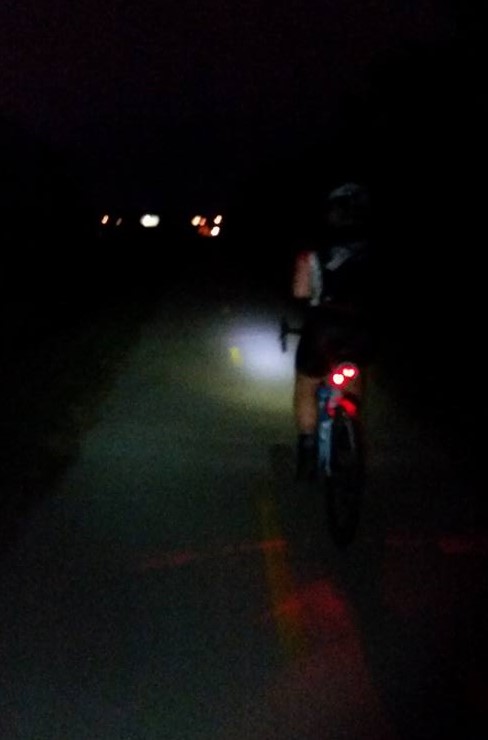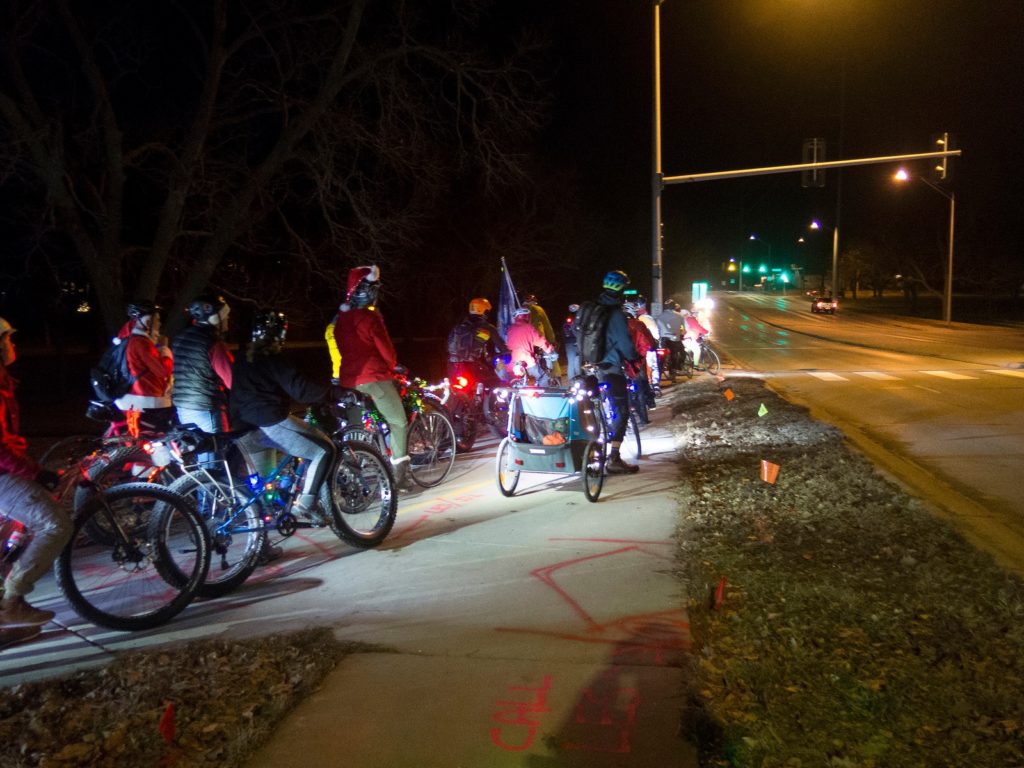Have you noticed daylight fading before you get home? Or missing it when you begin your commute in the morning? It’s bad enough when you think you’ll be back in plenty of time and don’t need to take your light only to find out that you really did need it. But what if you don’t have a working light to begin with? There are plenty of people on bikes going about their business after the light fails, or before the sun rises. For some the added expense of a light may not be in the family budget. There’s also always the very real possibility of it getting stolen. So what’s a night rider to do? Pepe’s Kitchen at 1311 S. 11th St. gave away about two dozen lights this evening to people who came to his restaurant after learning of the free lights. Pepe came up with the idea after seeing so many riders without them after dark. For the next two Mondays he’ll be distributing them from 5:00-7:00, or I expect as long as supplies last. I suspect he’d also take donations of lights to give away at the Kitchen if you’d like to help, He’ll also be carrying sets with him to give away. Pepe said “I just wanted do something simple in hopes that other business owners will be inspired to see a need in the community and do something to fulfill it. All I wanted to do was give away bike lights and I did.”

Courtesy Pepe’s Kitchen
This rest of this post is adapted from one posted a year ago because it’s that time again.
The weather is still fine for riding, but sunlight is in increasingly shorter supply. Nebraska law requires reflectors, and for lights to be visible at 500 feet one-half hour before sunrise and one-half hour after sunset. Also- do remember to be humane towards the other cyclists around you on the trails. If you’ve ever ridden in the dark on a trail behind someone with a blinking red light, you know how blinding one with high lumens can be. If you have the option, try putting it on a slow pulse, solid red, or off entirely if you have good rear reflectors. As for headlights, yes, very bright headlights are desirable and often necessary, but when approaching another cyclist, it can be like driving with your brights on. Turn your light to a lower setting, or turn it to the side until the oncoming cyclist is past. It’s also surprising the number of other trail users with no lights and no reflective gear; be they dog walkers, runners, or cyclists. Don’t be like them. Also, it’s easy to get caught out after dark, so try to bring your lights with you even if you think you’ll be home sooner. There are fun options for lights to clip onto your spokes that make attention-getting patterns. Also, studies show that the pattern a human leg makes with a reflective pedal strap on it while cycling (or running) gets attention best.
From the NHTSA: “Lights or retroreflective material attached to moving extremities (i.e., wrists and ankles) can create the perception of human movement and increase cyclist visibility (Koo & Huang, 2015; Karsch et al., 2012). A study of the effectiveness of different configurations of flashing lights on bicyclists’ joints found that lights placed on the lower body (hips, knees, and ankles) were the most effective in increasing bicyclist visibility (Koo & Huang, 2015). See also the Pedestrian Safety chapter, Section 4.3 on pedestrian conspicuity measures for more information.”

You may want to ride blazing-fast at night but don’t out-ride the cone of your headlight.
Do you know the rest of Nebraska State law in regards to lights and reflectors? No? Then here you go.
Lights and Reflectors: Nebraska Statute 60-6, 318: Equipment on Bicycles; Lights.
(1) When in use at nighttime, a bicycle shall be equipped with a light visible from a distance of at least five hundred feet to the front on a clear night and with a red reflector on the rear of a type which is approved by the Department of Motor Vehicles or a local authority and which is visible on a clear night from all distances between one hundred and six hundred feet to the rear when directly in front of lawful lower beams of headlights on a motor vehicle. A red light visible from a distance of five hundred feet to the rear may be used in addition to such red reflector.
Nebraska Statute 60-6, 319:
Bicycles; reflective device or material.
All bicycles shall be equipped with tires bearing a white or silver retroreflective material on each side or a wide-angle reflector mounted on the spokes of each wheel. Such retroreflective material shall be at least three-sixteenths of an inch wide, shall be affixed as an integral part of the tire or wheel, and shall remain effective for the life of the tire or wheel. The spoke-mounted wide-angle reflector devices shall have a reflective surface of at least two square inches and shall be clear, amber, or red in color. Both the retroreflective tires and wide-angle spoke reflectors shall be visible during the hours of darkness from four hundred feet when viewed under low beam headlights of a motor vehicle under normal atmospheric conditions when the bicycle is traveling at a ninety degree right angle to the direction of travel of the motor vehicle and is directly in front of such motor vehicle. Such reflective devices shall remain visible when the bicycle is turned forty degrees in either direction from such angle and crosses directly in front of such motor vehicle at a distance of four hundred feet.

Riding on the trails after dark can be fun. There are a lot of light options out there now to make your bike be visible and have fun doing it. Another good article about safely riding at night from Bike Walk NC can be found here.
Finally, here’s another reason to do your errands and commuting by bike, in the daytime or nighttime.
Biking Like the Dutch Could Erase Entire Countries’ Carbon Footprints
A new study shows how more pro-bike policies could have a major impact on climate change. For those who dream of a world where bike lanes are even more traveled than roadways for cars, a new data point shows how much impact such a shift could have on the climate crisis.
Worldwide, only five percent of daily trips are made by bicycle, but far more could be. According to one climate action group, 50 percent of journeys are less than 3.2 kilometers long, a short enough distance to be covered by bike with relative ease.
Researchers used the Netherlands — a country known for its strong cycling culture — to examine what would happen if more of these brief trips were made by bicycle. The University of Southern Denmark study found that if the entire world pedaled as much as the Dutch do, global carbon emissions would fall by nearly 700 million tonnes per year. That’s more than Canada’s entire carbon footprint.
The authors tout their research as proof that policies for a more cyclist-friendly world could make a major difference in the fight against climate change. “Lessons learned from successful experiences in countries like Denmark and the Netherlands…would be essential. These include but are not limited to, for example, proper bicycle lanes planning and construction, pro-bicycle education and culture, and policies to discourage car use through tax.”
